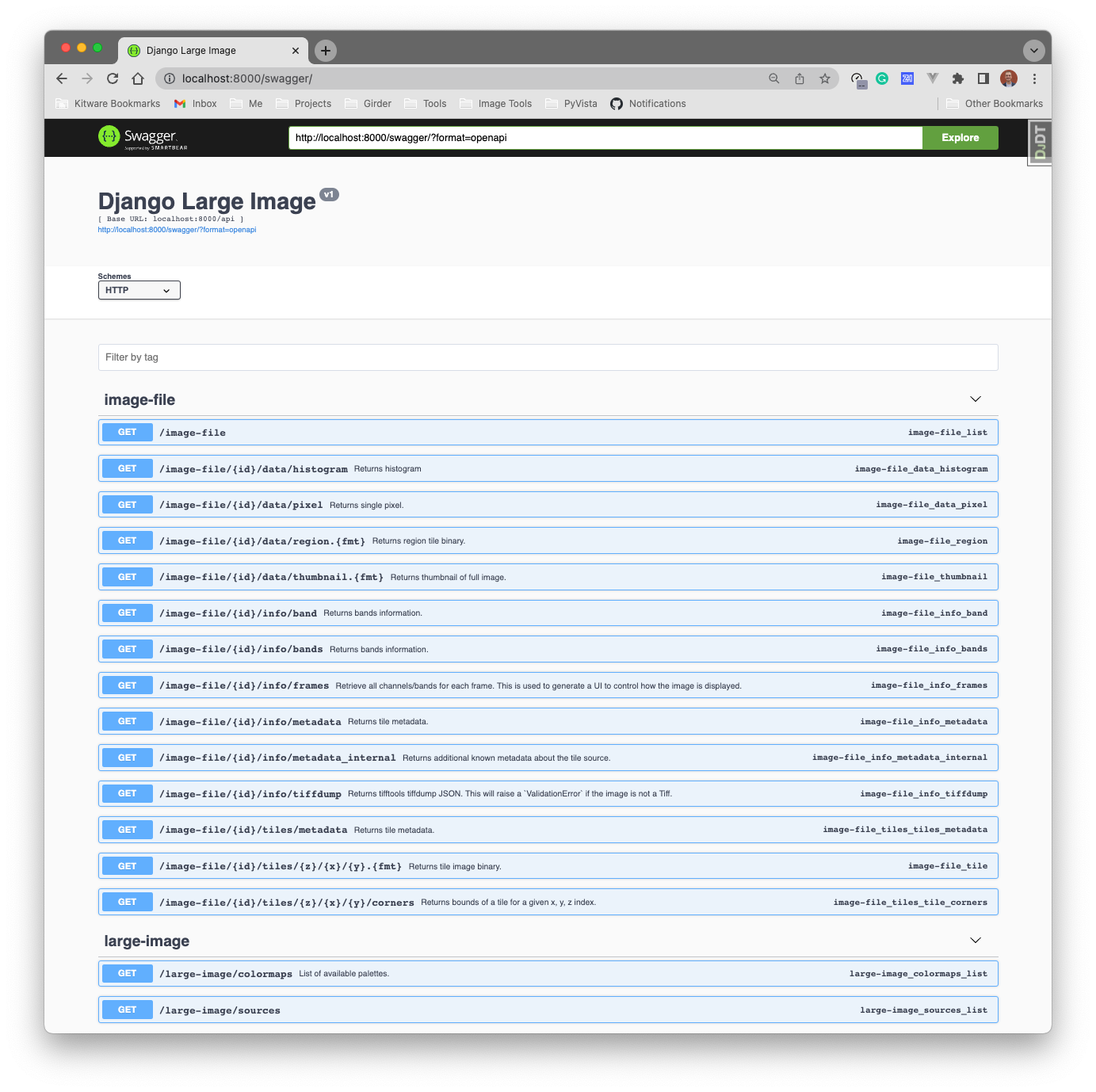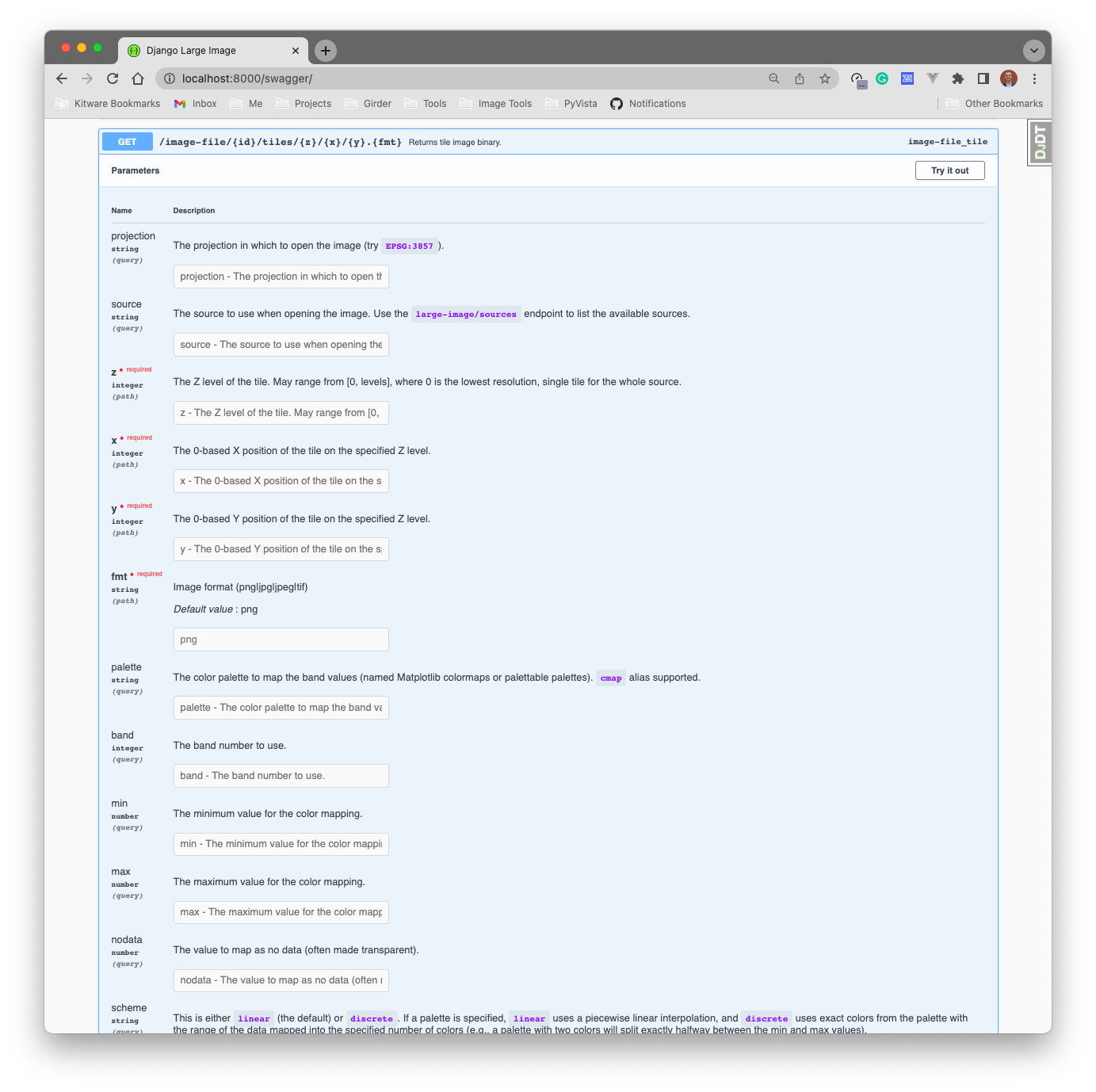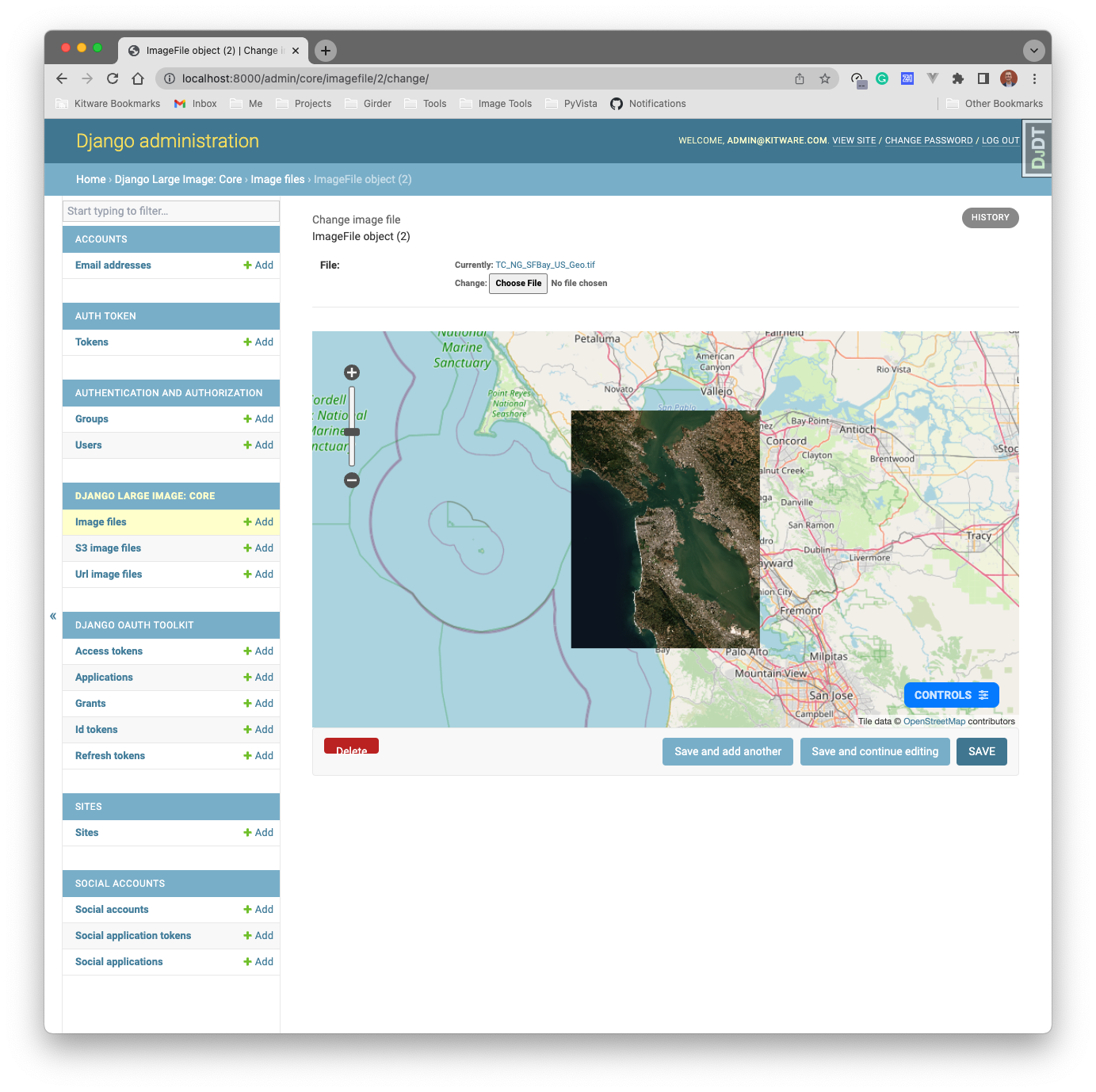No project description provided
Project description
django-large-image
Dynamic tile server in Django
django-large-image is an abstraction of large-image
for use with django-rest-framework providing viewset mixins for endpoints to
work with large images (Cloud Optimized GeoTiffs or medical image formats) in
Django. The dynamic tile server provided here prevents the need for
preprocessing large images into tile sets for viewing interactively on
slippy-maps. Under the hood, large-image applies operations (rescaling,
reprojection, image encoding) to create image tiles on-the-fly.
| OpenAPI Documentation | Tiles Endpoint |
|---|---|
 |
 |
Overview
This package brings Kitware's large-image to Django by providing a set of abstract, mixin API viewset classes that will handle tile serving, fetching metadata from images, and extracting regions of interest.
django-large-image is an installable Django app with
a few classes that can be mixed into a Django project (or application)'s
drf-based viewsets to provide tile serving endpoints out of the box. Notably,
django-large-image is designed to work specifically with FileField
interfaces with development being tailored to Kitware's
S3FileField. GeoDjango's GDALRaster
can also be used by returning GDALRaster.name in the get_path() override.
This package ships with pre-made HTML templates for rendering geospatial image tiles with CesiumJS and non-geospatial image tiles with GeoJS.
Features
Rich set of RESTful endpoints to extract information from large image formats:
- Image metadata (
/metadata,/internal_metadata) - Tile serving (
/tiles/{z}/{x}/{y}.png?projection=EPSG:3857) - Region extraction (
/region.tif?left=v&right=v&top=v&bottom=v) - Image thumbnails (
/thumbnail.png) - Individual pixels (
/pixel?left=v&top=v) - Band histograms (
/histogram)
Support for general FileField's or File URLs
- Supports django's FileField
- Supports
S3FileField - Supports GDAL's Virtual File System for
s3://,ftp://, etc. URLs
Miscellaneous:
- Admin interface widget for viewing image tiles.
- Caching - tile sources are cached for rapid file re-opening
- tiles and thumbnails are cached to prevent recreating these data on multiple requests
- Easily extensible SSR templates for tile viewing with CesiumJS and GeoJS
- OpenAPI specification
Installation
Out of the box, django-large-image only depends of the core large-image
module, but you will need a large-image-source-* module in order for this
to work. Most of our users probably want to work with geospatial images so we
will focus on the large-image-source-gdal case, but it is worth noting that
large-image has source modules for a wide variety of image formats
(e.g., medical image formats for microscopy).
See large-image's
installation instructions for more details.
Tip: installing GDAL is notoriously difficult, so at Kitware we provide
pre-built Python wheels with the GDAL binary bundled for easily installation in
production environments. To install our GDAL wheel, use:
pip install --find-links https://girder.github.io/large_image_wheels GDAL
pip install \
--find-links https://girder.github.io/large_image_wheels \
django-large-image \
large-image-source-gdal
Usage
Simply install the app and mixin one of the mixing classes to your
existing django-rest-framework viewset.
# settings.py
INSTALLED_APPS = [
...,
'django_large_image',
]
The following are the provided mixin classes and their use case:
LargeImageMixin: for use with a standard, non-detailViewSet. Users must implementget_path()LargeImageDetailMixin: for use with a detail viewset likeGenericViewSet. Users must implementget_path()LargeImageFileDetailMixin: (most commonly used) for use with a detail viewset likeGenericViewSetwhere the associated model has aFileFieldstoring the image data.LargeImageVSIFileDetailMixin: (geospatial) for use with a detail viewset likeGenericViewSetwhere the associated model has aFileFieldstoring the image data that is intended to be read with GDAL. This will access the data over GDAL's Virtual File System interface (a VSI path).
Most users will want to use LargeImageFileDetailMixin and so the following
example demonstrate how to use it:
Specify the FILE_FIELD_NAME as the string name of the FileField in which
your image data are saved on the associated model.
# viewsets.py
from django_large_image.rest import LargeImageFileDetailMixin
class MyModelViewSet(viewsets.GenericViewSet, LargeImageFileDetailMixin):
... # configuration for your model's viewset
FILE_FIELD_NAME = 'field_name'
# urls.py
from django.urls import path
from rest_framework.routers import SimpleRouter
from myapp.viewsets import MyModelViewSet
router = SimpleRouter(trailing_slash=False)
router.register(r'api/my-model', MyModelViewSet)
urlpatterns = [
# Additional, standalone URLs from django-large-image
path('', include('django_large_image.urls')),
] + router.urls
And that's it!
Example Code
To use the mixin classes provided here, create a model, serializer, and viewset in your Django project like so:
# models.py
from django.db import models
from rest_framework import serializers
class ImageFile(models.Model):
name = models.TextField()
file = models.FileField()
class ImageFileSerializer(serializers.ModelSerializer):
class Meta:
model = ImageFile
fields = '__all__'
# admin.py
from django.contrib import admin
from example.core.models import ImageFile
@admin.register(ImageFile)
class ImageFileAdmin(admin.ModelAdmin):
list_display = ('pk', 'name')
Then create the viewset, mixing in the django-large-image viewset class:
# viewsets.py
from example.core import models
from rest_framework import mixins, viewsets
from django_large_image.rest import LargeImageFileDetailMixin
class ImageFileDetailViewSet(
mixins.ListModelMixin,
viewsets.GenericViewSet,
LargeImageFileDetailMixin,
):
queryset = models.ImageFile.objects.all()
serializer_class = models.ImageFileSerializer
# for `django-large-image`: the name of the image FileField on your model
FILE_FIELD_NAME = 'file'
Then register the URLs:
# urls.py
from django.urls import path
from example.core.viewsets import ImageFileDetailViewSet
from rest_framework.routers import SimpleRouter
router = SimpleRouter(trailing_slash=False)
router.register(r'api/image-file', ImageFileDetailViewSet)
urlpatterns = [
# Additional, standalone URLs from django-large-image
path('', include('django_large_image.urls')),
] + router.urls
You can also use an admin widget for your model:
<!-- templates/admin/myapp/imagefile/change_form.html -->
{% extends "admin/change_form.html" %}
{% block after_field_sets %}
<script>
var baseEndpoint = 'api/image-file';
</script>
{% include 'admin/django_large_image/_include/geojs.html' %}
{% endblock %}
Please note the example Django project in the project/ directory of this
repository that shows how to use django-large-image in a girder-4 project.
Customization
The mixin classes modularly designed and able to be subclassed
for your project's needs. While the provided LargeImageFileDetailMixin handles
FileField-interfaces, you can easily extend its base class,
LargeImageDetailMixin, to handle any mechanism of data storage in your
detail-oriented viewset.
In the following example, I will show how to use GDAL compatible VSI paths
from a model that stores s3:// or https:// URLs.
# model.py
from django.db import models
from rest_framework import serializers
class URLImageFile(models.Model):
name = models.TextField()
url = models.TextField()
class URLImageFileSerializer(serializers.ModelSerializer):
class Meta:
model = URLImageFile
fields = '__all__'
# viewsets.py
from example.core import models
from rest_framework import mixins, viewsets
from django_large_image.rest import LargeImageDetailMixin
from django_large_image.utilities import make_vsi
class URLLargeImageMixin(LargeImageDetailMixin):
def get_path(self, request, pk=None):
object = self.get_object()
return make_vsi(object.url)
class URLImageFileDetailViewSet(
mixins.ListModelMixin,
viewsets.GenericViewSet,
URLLargeImageMixin,
):
queryset = models.URLImageFile.objects.all()
serializer_class = models.URLImageFileSerializer
Here is a good test image: https://oin-hotosm.s3.amazonaws.com/59c66c5223c8440011d7b1e4/0/7ad397c0-bba2-4f98-a08a-931ec3a6e943.tif
Non-Detail ViewSets
The LargeImageMixin provides a mixin interface for non-detail viewsets (no
associated model or primary key required). This can be particularly useful if
your viewset has custom logic to retrieve the desired data.
For example, you may want a viewset that gets the data path as a URL embedded
in the request's query parameters. To do this, you can make a standard ViewSet
with the LargeImageMixin like so:
# viewsets.py
from rest_framework import viewsets
from rest_framework.exceptions import ValidationError
from django_large_image.rest import LargeImageMixin
from django_large_image.utilities import make_vsi
class URLLargeImageViewSet(viewsets.ViewSet, LargeImageMixin):
def get_path(self, request, pk=None):
try:
url = request.query_params.get('url')
except KeyError:
raise ValidationError('url must be defined as a query parameter.')
return make_vsi(url)
Project details
Release history Release notifications | RSS feed
Download files
Download the file for your platform. If you're not sure which to choose, learn more about installing packages.
Source Distribution
Built Distribution
Hashes for django_large_image-0.4.1-py3-none-any.whl
| Algorithm | Hash digest | |
|---|---|---|
| SHA256 | 9a42fe2ef511135df6575bd27b74775e692473724565dd63884ec7d8fe674c8c |
|
| MD5 | 0f53eb2e25c5ea5d07b21505cf15ae5f |
|
| BLAKE2b-256 | fe125274175685569bb674a8049ad44068b7e5f2c9dd3d73b12e4d23e21ceec4 |


















